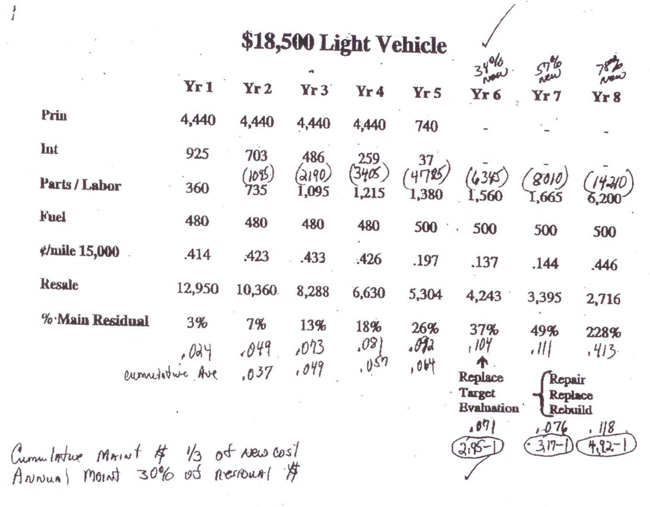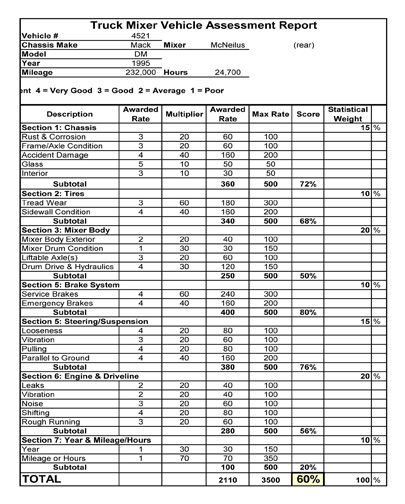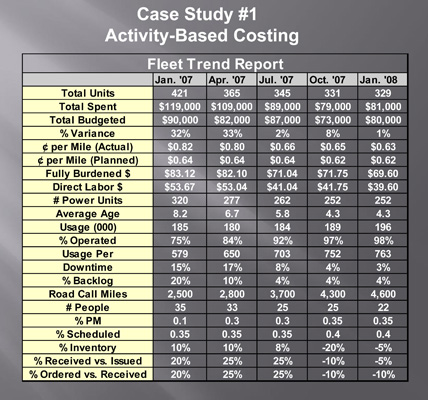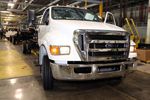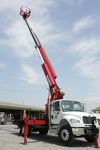For the Facilities & Transportation Fleet team at Indianapolis Power & Light Co., the key to productivity and efficiency is not just the programs and technologies that have been put in place. Equally important and absolutely essential, they note, is to ingrain a process of organizational efficiency throughout the culture of the operation.
Keith Dunkel, team leader and fleet manager, Kim Garner, fleet administration, and Les Gose, fleet maintenance at IPL, all point to the successful implementation of the 5S methodology within the fleet maintenance operation. This workplace organization methodology, based on five Japanese words all beginning with the letter “S” when translated into English (Sort, Set in Order, Shine, Standardize and Sustain), has benefited the fleet’s maintenance shops through improved organization of work spaces.
“A primary focus was on the efficient and effective storage of work tools and supplies, maintaining the work area and these items, and sustaining the new order,” Dunkel said. “The decision-making process usually comes from a dialogue about standardization, which builds understanding among employees of how their work should be done.”
At IPL, the 5S methodology has brought a new cultural mindset to shop floor efficiency and safety within the fleet maintenance operation. “It’s a process that builds collaboration among employees and management specific to work design and flow,” Dunkel stated. “In addition to improving shop safety by reducing hazards, it has also provided structure within the shop environment to identify and reduce waste.”
Today, IPL crew leaders, technicians and management personnel use the 5S methodology to effectively run shop operations. A weekly safety walk, for example, is used to identify housekeeping issues, such as defective lighting or other concerns, based on a comprehensive checklist of items specific to the operation and environment.
Organized Approach
An organized approach is also in place in other areas of the IPL fleet and maintenance operation. “Three years ago,” explained Gose, “we brought in NAPA to manage our parts system. NAPA now operates our parts room as a private store, staffed 16 hours per day. The facility exclusively serves the IPL fleet, handles paperwork for our business with a local tire vendor, and as an added convenience, IPL employees can make purchases for personal use.
“With this arrangement,” Gose continued, “we are ensured competitive pricing within a consigned parts format. This has given us access to a substantial inventory without tying up financial resources for owned inventory.”
Gose also explained that IPL and NAPA are working closely together to ensure that the parts supplier is prepared to provide the wide variety of standard and specialized items needed for utility vehicles. “Our initiative is to ensure that NAPA understands our needs,” he said. “We do not want to wait for parts that we should have in stock and we expect NAPA to adjust the consignment inventory as our specs change.
“We have established and track metrics specifically to the NAPA operation,” Gose continued. “Those target wait times, fill rates and inventory location accuracy. We believe these to be core competencies for parts management and are integral to the productivity of our technicians.”
The IPL fleet is serviced in two locations, Dunkel noted. “At our main hub in Indianapolis we house about 80 percent of the fleet of 422 vehicles,” he related. “At a satellite facility we handle the other 20 percent. About 80 percent of the fleet is used in operations across our 528-square-mile service territory and the rest is allocated to our three generating plants.”
Meeting Needs
The composition of IPL’s fleet is designed to meet the needs of field operations that maintain 835 circuit miles of transmission lines and approximately 12,668 circuit miles of distribution lines, as well as 144 substations. A total of 88 heavy-duty units account for 20 percent of the fleet, another 92 are medium-duty models and the balance consists of 242 light-duty vehicles.
Primary makes represented in the IPL fleet include International heavy-duty, Freightliner and Ford medium-duty, and Chevrolet and Ford light-duty models. IPL’s alternative fuel vehicles are primarily within the light-duty segment of the fleet and use E85 from a central fueling station.
Vehicle types at IPL are varied for line, substation maintenance and construction needs, Dunkel pointed out. Aerial units supplied mainly by Altec include 45-foot models for trouble trucks, 55-foot models for line truck material handlers, 85-foot high reach noninsulated and 125-foot insulated units, and there are 42-foot material handlers and articulating squirt booms.
Also in operation at IPL are digger derricks, light-duty cranes, cable pullers and rodders. Truck types include step and hi-cube vans, 3/4-ton vans, and 1/4-, 1/2-, 3/4- and 1-ton pickups. The fleet also has sedans, minivans and SUVs, and the maintenance staff services and repairs support equipment such as easement rigs, backyard buckets, tensioners, wire reel trailers, forklifts, backhoes and small excavators.
“We have established replacement cycles based on vehicle size and use,” Garner said. “Light-duty models are in service for five years or 60,000 miles, trouble trucks are replaced after seven years and line trucks see 10 years of service in our fleet.
“For remarketing our retired heavy-duty trucks, and some nonroad equipment, we have been using the services of J.J. Kane Auctioneers,” Garner related. “We were working with a local auction company, but Altec brought J.J. Kane to our attention because of their specialization in selling construction utility equipment.
“They know the markets where we can get the best resale value for our trucks,” Garner added. “Overall, it’s been a very smooth and effective process. We have maximized our recovery dollars using the J.J. Kane process.”
Software is also in place to help specify and manage the IPL fleet, Gose noted. For example, there’s Diamond Logic Builder at International Trucks’ Body Builder Resource Center, as well as the CFAW fleet maintenance management solution and E.J. Ward automated fuel management software and reporting tools.
In the shop, Gose reported, technicians are trained on a regular basis and have multiple diagnostic tools at their disposal. Included are the Rotunda (IDS) service tool for Ford vehicles, Mentor, Pegasus, INSITE (Cummins) and Tech II diagnostic equipment, and the ServiceMaxx diagnostic and programming tool for Navistar MaxxForce engines.
Accelerated Implementation
“In 2010, we started using the Telogis Fleet management solution for vehicle telematics,” Dunkel said. “Initially, we phased in 50 trucks, but once we experienced the wealth of the data available, we accelerated our implementation plan.
“By the end of the first year we had over 300 vehicles on the system,” Dunkel continued. “The telematics solution reports GPS location data, engine performance, idle, PTO and battery time, and odometer readings, along with hard braking and acceleration information.
“Now that we have over two full years of baseline data from vehicle electronics systems over the Telogis solution, we’re taking it to the next level,” Dunkel added. “We have completed the next step [Enterprise Level] using the system’s InSight Alerts function to develop driver scorecards and a [key performance indicators] Dashboard.
“With these capabilities,” Dunkel stated, “our field operation teams use the system to enhance productivity by determining arrival and departure times at job sites. In the fleet department, we will be able to model scenarios that will show us the impact on costs of reducing idle time and get alerts to mechanical conditions previewing potential costly breakdowns and repairs.”
IPL’s management team, Dunkel added, has given strong support for this investment in vehicle telematics. “This technology has provided new and valuable insights into how our trucks are used,” he said, “giving us opportunities to lower operating costs, improve driving behaviors and better manage our assets.”
About IPL: Indianapolis Power & Light Co. provides retail electric service to more than 470,000 residential, commercial and industrial customers in Indianapolis, as well as portions of other central Indiana communities surrounding Marion County. During its long history, IPL has supplied its customers with some of the lowest-cost, most reliable power in the country. Its parent company, AES Corp., provides affordable, sustainable energy to 25 countries through a diverse portfolio of distribution and generation businesses.
About the Author: Seth Skydel has more than 27 years of truck- and automotive-related publication experience. In his career, he has held editorial roles at numerous national business-to-business publications focusing on fleet and transportation management, vehicle and information technology, and industry trends and issues.




